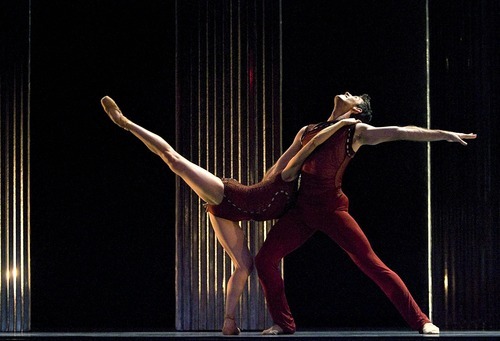This is an archived article that was published on sltrib.com in 2011, and information in the article may be outdated. It is provided only for personal research purposes and may not be reprinted.
Yes, you do know the melody of Maurice Ravel's "Bolero." The sinuous tune and the ever-repeating rhythm that underlies it were already ubiquitous when the 1979 movie "10" made "Bolero" inescapable.
Hearing the full version of "Bolero" offers the listener 19 chances to memorize its famous theme, because that's how many times Ravel repeats it — the work starts with a solitary flute and gradually builds to a full-orchestral orgy of sound.
Ballet West artistic director Adam Sklute programmed choreographer Nicolo Fonte's new "Bolero" with Jiri Kylian's "Sinfonietta" and George Balanchine's "Chaconne" for a triple-bill concert of contemporary ballet at Salt Lake City's Capitol Theatre. All three works will be new to Ballet West's dancers and audience.
—
Reinventing 'Bolero' • "Bolero" was written as a ballet in 1928 and has been rechoreographed many times, not always with success. The music's fame and its repetitive crescendo toward passionate fulfillment have made "Bolero" something of a cliché.
That's why Fonte had a quick response when Oregon Ballet Theatre asked him to create a new ballet set to "Bolero." "I flat-out refused," Fonte said. "I told them 'I'm not interested. I don't want to go near that music.' "
After some cajoling, Fonte listened to "Bolero" as if he had never heard it before and found he loved it. The choreographic challenge of the piece's hypnotic repetition didn't intimidate him. Finding a way to make "Bolero" say something new and original did.
Research into Ravel's original intention for the piece provided a "Eureka!" moment. Ravel had envisioned the ballet performed before a backdrop of a factory to highlight the mechanical nature of its rhythmic underpinning, though it wasn't traditionally performed that way.
With that image in mind, Fonte came up with the idea of filling the stage with corrugated metal panels in constant motion, allowing dancers to be concealed, then gradually revealed.
"I didn't want to put a factory onstage, but I did like the idea of these panels," Fonte said. "In the beginning they are like shields, guarding ourselves from one another. Gradually, body parts are revealed from behind the shields — an arm or a leg comes out."
As the ballet continues, the panels fly upward one by one, the music becomes louder and more passionate, and the dancers, now fully revealed, engage with each other.
—
'Dangerously uncomfortable' • Fonte's movement style takes the two-dimensional lines of classical ballet and exaggerates the angles into three dimensions.
During a recent rehearsal, ballet mistress Pamela Robinson-Harris tells the dancers: "When it feels dangerously uncomfortable, that's good."
Principal dancer Romi Beppu, who is featured in a pas de deux with Michael Bearden during "Bolero," sees Fonte's ballet as a metaphor for a hectic world sped by social technology that promises connection, but delivers isolation instead.
"Throughout the piece, the masks are removed, and relationships, unity and community develop," Beppu said. "Even though we are very advanced today and live in a rat-race world, at the end of the day the same thing our ancestors searched for still remains — we need human interaction."
One theme that ties the three works together is that they are about "an exalted experience," Sklute said. "Each one, in differing ways, is moving us onto another plane of existence."
—
Dancing toward bliss • "Bolero's" fulfilling journey toward human interaction and connection is one iteration of that idea. Kylian, a Czech choreographer, uses the stunning music of countryman Leos Janácek as the basis for a ballet filled with life-affirming energy, with a rendering of the Czech landscape as a backdrop.
"It looks a bit like the Utah landscape, which I love," Sklute said. "At the end of the ballet, the dancers reach out into the landscape and walk off into the distance. It's such a beautiful moment of exultation."
The famed "Dance of the Blessed Spirits" — incidental ballet music from C.W. Gluck's 1762 French opera "Orfeo ed Euridice" — inspired Balanchine's "Chaconne."
The choreography blends Balanchine's signature neo-classicism with elements of French court dance to create a heavenly plane of existence — the Elysian fields of Gluck's opera.
Sklute says the program shows off the full Ballet West company and gives feature roles to many dancers, all while serving up three kinds of bliss.
'Bolero' and more
Ballet West presents regional premieres of three contemporary ballets, headlined by Nicolo Fonte's "Bolero," set to Ravel's famous score. Also on the program: Jiri Kylian's "Sinfonietta," to music of Janácek, and George Balanchine's "Chaconne," to music of Gluck.
When • April 8, 9 and 13-16 at 7:30 p.m., with a 2 p.m. matinee April 16
Where • Capitol Theatre, 50 W. 200 South, Salt Lake City
Tickets • $18-$74, at 801-355-ARTS or http://www.arttix.org. (Discounts are available to groups of 15 or more; call 801-869-6900.)







